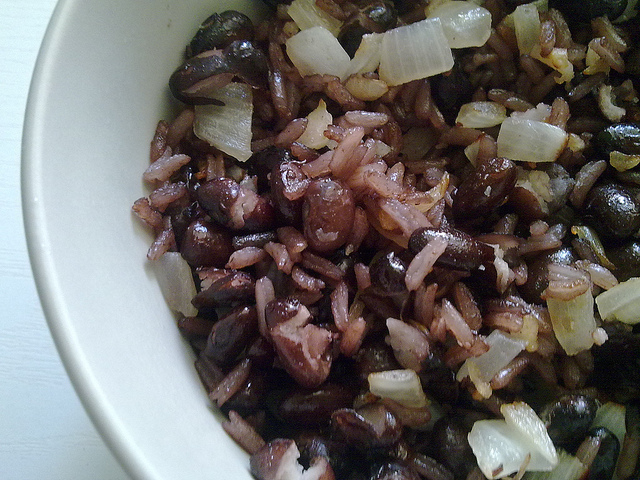Two or three weeks ago, my boys and their father went on a much-needed road trip to visit family in Kansas City. When they came back, I overheard Primo and Secondo talking about how they’d eaten rice and beans while they were away. “Rice and beans?” I asked my husband. “Where did they eat rice and beans?”
“At my brother’s,” he answered matter-of-factly.
My husband’s Midwestern family traveled to Costa Rica for our wedding nearly ten years ago. They’d never been there before, and like most of our American guests who were there for the first time, they loved gallo pinto, the Costa Rican version of rice and beans, doused in local Salsa Lizano, often served with sour cream, eggs and tortillas for breakfast. And like many of our guests, they came back to the U.S. and gallo pinto immediately went into their regular breakfast and dinner rotation. Some brought Salsa Lizano back with them, others were excited to realize they could find it locally. Some add mushrooms, roasted red peppers, and other non-traditional ingredients.
This is an area in which, I’m ashamed to admit, my children’s bicultural education is sorely lacking. I make delicious tamales at Christmastime and I’m often asked to take my refried beans to parties. But really, that’s about it. I don’t remember the last time I made gallo pinto or arroz con pollo.
It’s partly due to the fact that I never really learned to make a lot of these traditional dishes. When we lived in the U.S. in the seventies, my Costa Rican mother — a great cook — learned to make taco salad, chicken-tortilla casserole and three-bean salad, and these were staples of my existence even after we moved back to Costa Rica. If we wanted white rice and frijoles molidos, we had lunch at Abuelita’s or at one of my aunts’.
So my children aren’t exposed to all that many of the traditional foods I grew up with, because I don’t make them. If anything, they eat food from other Latin American countries—buñuelos drizzled with honey after Spanish school, pupusas, empanadas and salteñas, all of which are cheap and plentiful in our area, and also delicious.
I should probably experiment a little more, get away from quesadillas and fish sticks a bit and make things like arroz con pollo and Caribbean-style rice-and-beans like I used to. I realize, though, that I’m not going to magically become the cook my Abuelita was, that work keeps me busy and out of the kitchen, that my reality is just different.
Still, though, I’m trying to incorporate some simple foods that remind me of my childhood. We eat gallos — avocado, refried beans or scrambled eggs, you name it, stuffed into a corn tortilla — on a regular basis, and it’s the simplest dinner ever. And I’ve become a bit obsessed with panela (the brown, unrefined sugar that I knew as tapa de dulce), which was one of my favorite things when I was growing up. I make a syrup out of it and use it on pancakes, drizzle it over oatmeal, and I even use it instead of honey or maple syrup when I make granola or peanut butter cookies. The flavor never fails to evoke mornings at camp, where after a cold shower outdoors in the dark 6:00 a.m., we were rewarded with a steaming tin cup full of aguadulce. A hot beverage never tasted that good.
So I try to add some of the Costa Rican foods of my childhood, but I don’t feel guilty when we break into the fish sticks. My children are not me, after all, and they will have different memories when it comes to food, different memories from my own. And that’s okay, because although when I think of gallo pinto when I remember my childhood, I’m just as likely to think of chicken tortilla casserole.
{Image via Labiascovegmenu}



This is a really good topic Kimberly, sometimes we forgot to share our culture with our kids. In home we eat only Colombian food (lentils, beans, vegetables soups, pasta, “arepas”, “caldos”, fruit juices with milk and yogurt!, “arroz con pollo”) so when my kids travel to Colombia they really don’t know the difference about food. The good part is that now you can begin introduce more Latin foods that for your kids and you can found a lot of recipes in youtube.
I would love to have been exposed to more of my culture’s food as a kid, but it simply wasn’t there. I discovered it more as I grew up and now I love it. I want to share it with others, and of course my kids would get a taste.
That is so delicious